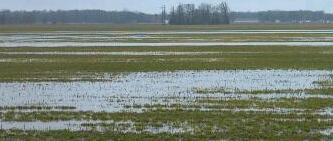Excessive rains may lead to a loss of nitrogen in wheat fields
Providing the optimum amount of nitrogen fertilizer to the wheat crop depends, in part, on both minimizing and estimating nitrogen losses.
Much of Michigan’s wheat growing area received excessive amounts of rainfall in recent days. In some areas, repeated rainfalls have led to prolonged flooding and significant runoff. For those wheat fields that have already received the bulk of their fertilizer nitrogen (N), growers can expect to have lost some of the nutrient.

Excessive rains have led to significant flooding
in many fields throughout the mid-state,
Saginaw Valley and Thumb regions.
Photo credit: Martin Nagelkirk, MSUE
Of course, there are no models to accurately predict how much N may have been lost. Nitrate is the most vulnerable form of N under saturated conditions, as it readily leaches through coarse soils and is subject to converting to a gas (denitrification) when oxygen is limited. Fortunately, soil temperatures at the 2-inch depth remain cool (35 and 45 degrees), and this should significantly slow the process of denitrification. The cool temperatures may do little to curtail leaching, however. Fertilizer urea tends to be more stable. Within a few days following application, it converts to ammonium which is relatively stable under wet conditions (This ammonium will eventually convert to nitrate when soils warm to above 50 degrees.).
The highest loss of N will have likely occurred where 28% UAN has been applied. This is because 25 percent of the N is already in the nitrate form. For 28 % UAN applications on moderately well or well drained silt loam soils, it may be reasonable to suggest that 10 to 25 percent of the nutrient may be lost. The loss is likely to be less where urea was used.
To compound the uncertainty, growers should also consider the amount of N that may have moved laterally along with runoff water and eroding soil. In addition, the forecast suggests more rainfall during the week to come, in which case N could be moved further through the soil profile and potentially beyond the reach of future root growth.
Michigan State University Extension recommends that wheat receive most or all of its N no earlier than the latter half of April in order to minimize N movement and losses that often occur during March and early April rain events. As for this season, growers who have already applied their full rate of N should not need to apply supplemental N. However, if unusually high losses continue to occur in the weeks to come, some additional N as 28% UAN through streamer nozzles could be considered prior to flag leaf emergence (growth stage 8).



 Print
Print Email
Email




